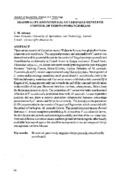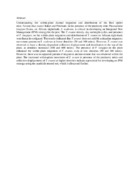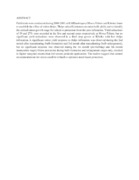Department of Crop Science
Browse by
©Karatina University
Recent Submissions
-
Seasonality and potential of Ceranisus menes for control of thrips on French beans
(Sida, 2008-10-22)- -
Home Sustainable Management of Invasive Pests in Africa Chapter Influence of Predatory Mites, Phytoseiulus longipes Evans. on the Within-Plant Diurnal Migration and Distribution of the Red Spider Mite, Tetranychus evansi, Baker and Pritchard on African Nightshade, Solanum scabrum
(Springer, 2020-07-14)Understanding the within-plant diurnal migration and distribution of the Red spider mite, Tetranychus evansi Baker and Pritchard, in the presence of the predatory mite Phytoseiulus longipes Evans, on African nightshade, ... -
Evaluation of biological attributes of a native egg parasitoid, Trichogrammatoidea sp. nr. lutea (girault), kenyan accessions
(2012-09-10)Objective: This study was carried out to evaluate the biological attributes that is, parasitism, adult progeny production, and sex ratio of 21 strains of a native egg parasitoid Trichogrammatoidea sp. nr. lutea Girault ... -
Biological control agents of aphids (Homoptera: Aphididae) on potatoes (Solanum tuberosumL) in Kenya
(2010)A field survey was conducted in four major potato growing areas in Kenya (Kiambu, Nyandarua, Meru and Molo Districts) during January and February, 2008 (short rains crop) and June 2008 (long rains crop) to determine the ... -
The Critical Onion Growth Stages For Selective Protection From Thrips Tabaci Lindeman (Thysanoptera:Thripidae) Infestation
(Kenya Agricultural Research Institute, Nairobi (Kenya), 2006-01)Field trials were conducted during 2000-2001 at KARIandrsquo;s Mwea-Tebere and Kiboko farms to establish the effect of onion thrips, Thrips tabaci Lindeman on onion bulb yields and to identify the critical onion growth ... -
Effect of temperature on the development of Orius albidipennis Reuter, a predator of the African legume flower thrips, Megalurothrips sjostedti Trybom
(2002)The effects of temperature on the development of Orius albidipennis (Reuter) (Hemiptera: Anthocoridae), reared on its prey, Megalurothrips sjostedti (Trybom) (Thysanoptera: Thripidae), were studied in the laboratory. Nymphal ... -
Scope for genetic enhancement of the parasitisation potential of four native strains of Trichogrammatoidea sp. nr. lutea Girault (Hymenoptera: Trichogrammatidae
(Taylor & Francis, 2007-09)In response to emerging interest in commercial mass production of Trichogramma for Helicoverpa armigera biocontrol in eastern Africa, laboratory experiments were undertaken to assess the scope for genetic enhancement of ... -
HOST-PLANT ACCEPTANCE, FECUNDITY AND LONGEVITY OF Tetranychus evansi (Acari: Tetranychidae) ON SELECTED TOMATO ACCESSIONS
(2009)Seventomato (Lycopersicon sp.) accessions wereevaluated for their resistance to thetomato red spider mite, Tetranychus evansi Baker and Pritchard, in the laboratory. Data recorded was: (i) trichome density and ... -
Antimicrobial acitivity of extracts from Tephrosia vogelii Hook F.
(2007-01-29)The dichloromethane extracts of the root and leaf of Tephrosia vogelii Hook F. (Family: Papilionaceae) grown in Kenya, were subjected to antimicrobial assays against Staphylococcus aureus, Escherichia coli and Fusarium ... -
Article Navigation JOURNAL ARTICLE Evidence for Potential of Managing Some African Fruit Fly Species (Diptera: Tephritidae) Using the Mango Fruit Fly Host-Marking Pheromone
(Entomological Society of America, 2012-12-01)We investigated conspecific and heterospecific oviposition host discrimination among four economically important fruit fly pests of mango in Africa (Ceratitis capitata, Wiedemann; C. fasciventris, Bezzi; C. rosa, Karsch, ... -
Leveraging Mobile Phones in Crop Pests and Disease Surveillance-Perspectives of Farmers in Kenya.
(Corpus publishers, 2023)Agriculture plays a crucial role in ensuring food security and employment in Kenya. However, farmers in the country have been struggling with low crop yields due to pests and diseases. To address this issue, mobile-based ... -
Spatio-temporal change of selected soil physico-chemical properties in grevillea-banana agroforestry systems.
(Elsevier Ltd, 2023-09-18)In Africa, banana is mainly produced by small-scale farmers under complex production systems for both home consumption and income generation. Low soil fertility continually constraints its production and farmers are embarking ... -
Crop Production in Irrigation Schemes in Turkana County, Kenya, Before and During COVID-19 (2018-2021)
(2023-08-11)Turkana County, located in the northwest of Kenya, is an arid county and the poorest in the country, with a poverty index of 79.3% vs. 34.4% for the country. Due to its aridity, crop production is severely ... -
Assessment of Production Constraints and Contribution of Avocado to Food Security and Income in the Mount Kenya Region, Kenya
(2023)Avocado (Persea americana Mill.) belongs to the family Lauraceae and it is an important crop to rural communities and economies in Kenya. Currently, avocado is grown in several agro ecological zones mainly by small-scale ... -
Farmer knowledge, management practices and occurrence of tomato root knot nematodes in Kenya.
(2023-08)Root-knot nematodes (RKNs) (Meloidogyne spp.) is a major constraint to tomato (Solanum lycopersicum L.) production in sub-Saharan Africa; yet there is low adoption of recommended nematode control measures in regions ... -
Allelic Variation of Terpene Synthases Drives Terpene Diversity in the Wild Species of the Freesia Genus.
(2023-03-18)Terpene synthases (TPSs) play pivotal roles in conferring the structural diversity of terpenoids, which are mainly emitted from flowers, whereas the genetic basis of the release of floral volatile terpenes remains largely ... -
Bradyrhizobium inoculation has a greater effect on soybean growth, production and yield quality in organic than conventional farming systems
(2021-06-22)Globally, organic farming and bradyrhizobia inoculation are gaining popularity as agronomically and environmentally sound soil management strategies with great potential to alleviate declining soil fertility, maintain ...



















